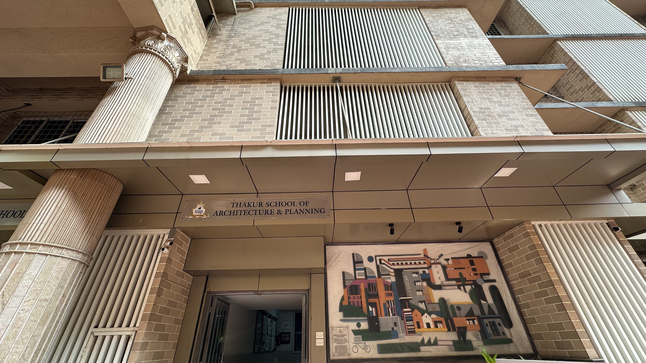
Step into a space where blueprints come alive, where the studio is more than a classroom, and where every sketch is a conversation between imagination and the real world. Welcome to the Thakur School of Architecture and Planning. Or simply, TSAP. Here, learning architecture is not just about understanding design. It is about living it.
In a world where architecture too frequently remains stuck between the pages of portfolios and the corners of computer monitors, TSAP challenges us to ask another question. How do we ready the next generation of architects not only to design buildings but to design the world around them? The answer is simple: connection.
Design Is Not Enough
Go into any design school and you’ll discover students spilling their hearts out onto tracing paper, computer models, and conceptual boards. But at some point between the studio and the site, a gap tends to emerge. An elegant concept on paper doesn’t always become a building that functions, endures, or holds meaning in its context.
TSAP sees this gap. And rather than wishing it away, the school has structured its whole approach to filling it. Here, design is never conceived in a vacuum. It is always tied to practice. Because at TSAP, the conviction is unmistakable — an architect’s education isn’t finished until the pencil meets the brick.
The Studio as a Lab for Reality
In TSAP, the design studio is not just an artistic environment. It is a small miniature world of architecture in process. The studio process is designed to mirror the actual rhythm of the professional practice. Students get educated to think as designers and behave like professionals.
From the first year on, students are invited to interact with real users, study existing sites, and grasp the broader forces that form our cities and communities. Whether designing a modest bus stop or redesigning an urban square, it’s all about context and purpose.
Faculty members lead, not teach. They provoke the students to explain their choices, to seek out options, and to never stop asking “why.” It is a culture of questioning, not copying. Because no magnificent edifice was ever created through the obedience of instructions.
Learning by Building
There is a quiet rush in watching your design take shape. TSAP introduces that rush into the learning experience. TSAP students don’t merely sketch buildings. They construct them — at least partially. Through construction workshops, model-making labs, and prototype prototypes, students start to grasp the essence of materials and the cadence of making.
The yearly design-build assignments are the best part. These aren’t just theoretical exercises. These are actual buildings for real people. A courtyard pavilion. A neighbourhood installation in a nearby community. A seating area that’s also a work of art. These are projects where drawings step off the page and into the world. And when that occurs, students start to feel the burden and the exhilaration of actual responsibility.
Beyond the Classroom Walls
TSAP does not teach architecture only inside its studios. The city becomes a classroom. The streets of Mumbai, the settlements of rural Maharashtra, the temples, the markets, the old mills — these are all living textbooks.
Field trips are routine. So are site surveys, heritage recording, and city mapping. Students interview locals, draw street sections, and record everything from informal markets to modernist landmarks. This is where theory intersects the smell of concrete and the noise of everyday life.
Internships are not an afterthought. They are milestones. TSAP’s deep connections with top architects, builders, and planners mean that students are working on real projects, with real deadlines, with real clients. It is not about exposure. It is about transformation.
A Culture of Collaboration
Architecture is never a one-man show. It’s always a dialogue between disciplines. And at TSAP, that reality is ingrained in the fabric of the place. Architecture students and planning students’ cross paths frequently. Artists, engineers, ecologists, and filmmakers come to workshops. Crits are open and lively. Discussions are free flow. And learning becomes communal.
Even student-led activities bear this ethos. Whether it is organizing design festivals, curating an exhibition, or hosting guest lectures, the ethos is one of participation, leadership, and collaborative growth.
Faculty as Mentors, Not Just Teachers
The core of TSAP’s strategy is the faculty. They are not merely teachers. They are active architects, urbanists, researchers, and first and foremost, mentors. They bring field experience and combine it with compassion in the classroom.
Their criticism isn’t about marks. It is about direction. Their questions aren’t a conclusion with “what have you done” but are taken to a further place of “who is this for” and “what change does it make.” They foster both skill and sensitivity.
Looking Ahead: The Architect as Changemaker
The world does not require architects who merely draw. It requires architects who listen, who flex, and who lead. TSAP’s purpose is to equip such changemakers. Through the intersection of design and practice, the school equips students not for careers, but for paths.
Whether the student proceeds to design skyscrapers, restore villages, or author urban futures, the groundwork is solid. The thinking, building, and designing responsibly are ingrained.
Conclusion: Where the Future Begins
TSAP isn’t merely an architecture school. It is a place where dreams intersect with discipline. Where ideas are formed into impact. And where learning is never divorced from doing.
For each student who enters with a fire to design, TSAP provides more than an education. It provides a compass — a means of charting the big, messy, gorgeous world of architecture with conviction, ability, and intention.
The world beyond is waiting. And thanks to TSAP, its future architects are prepared.
